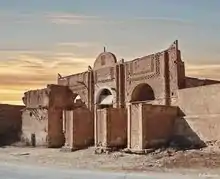Tuggurt Expedition (1552)
The Tuggurt expedition in 1552 aimed to obtain the submission of the Saharan cities of Tuggurt and Ouargla, seats of independent sultanates. Salah Rais, beylerbey of the regency of Algiers, was allied to the troops of the Kingdom of Ait Abbas, led by their sultan, Abdelaziz el Abbas.[2][3]
| Siege of Tuggurt (1552) | |||||||
|---|---|---|---|---|---|---|---|
 | |||||||
| |||||||
| Belligerents | |||||||
|
|
Sultanate of Ouargla | ||||||
| Commanders and leaders | |||||||
|
|
| ||||||
| Strength | |||||||
|
Regency of Algiers : 180 infantrymen[1] | Unknown | ||||||
| Casualties and losses | |||||||
| Unknown | Unknown, but high | ||||||
The sultan of Tuggurt, head of two prosperous cities and Saharan principalities, refused to pay tribute to the regency of Algiers, which therefore launched an expedition to subdue him and also take control at the same time of a caravan route for the Trans-Saharan trade in gold. Salah Rais, at the head of 1000 cavalry and 8000 infantry, as well as some pieces of artillery, was joined by 180 arquebusiers and 1,600 horsemen from the Kabyles of Beni Abbes. The latter saw the expedition as a chance to acquaint themselves with artillery, which they hoped to use to their advantage against attacks from the Turks of Algiers.[4]
In passing Salah Raïs subdued Biskra, previously attacked in 1542 by Hassan Pasha, because it had refused to pay tribute. Continuing south, he laid siege to Tuggurt. The local sultan, only 16 years old, retreated behind the city walls and hoped that the surrounding tribes, hostile to the Turks, would come to his rescue. Salah Raïs bombarded the defenses with cannon for three days. On the fourth day he attacked, massacred the city's inhabitants, and captured the young sultan.[5]
Salah Rais plundered the town, reputed to possess gold in quantity. He then took the road south to Ouargla. Faced with the methods of Salah Rais, the city's inhabitants fled and its sultan retreated with 4000 horsemen towards El Golea.[6] Only African merchants and marabouts remained when Salah Raïs arrived. The two sultanates surrendered and promised to pay tribute, so he left again for Algiers[7]
References
- Féraud 1872, p. 219
- Roberts 2014, p. 195
- Gaïd 1978, p. 9
- Féraud, 2014, p. 219
- Grammont, 1998, p. 98-99
- Grammont p. 98-99, city name transcribed as Alcala
- Grammont, 1998, p. 98-99
Bibliography
- Hugh Roberts, Berber Government: The Kabyle Polity in Pre-colonial Algeria, Boston, I.B.Tauris, 2014, 352 p. (ISBN 1845112512)
- Mouloud Gaïd (1978). Chroniques des Beys de Constantine [Chronicles of the Beys of Constantine]. Algiers: Office des publications universitaires. p. 160 – via Google Books.
- Laurent-Charles Féraud, Histoire Des Villes de la Province de Constantine (History of the Cities of Constantine Provinces) : Sétif, Bordj-Bou-Arreridj, Msila, Boussaâda, vol. 5, Constantine, Arnolet, 1872 (reprinted 2011), 456 p. (ISBN 978-2-296-54115-3)